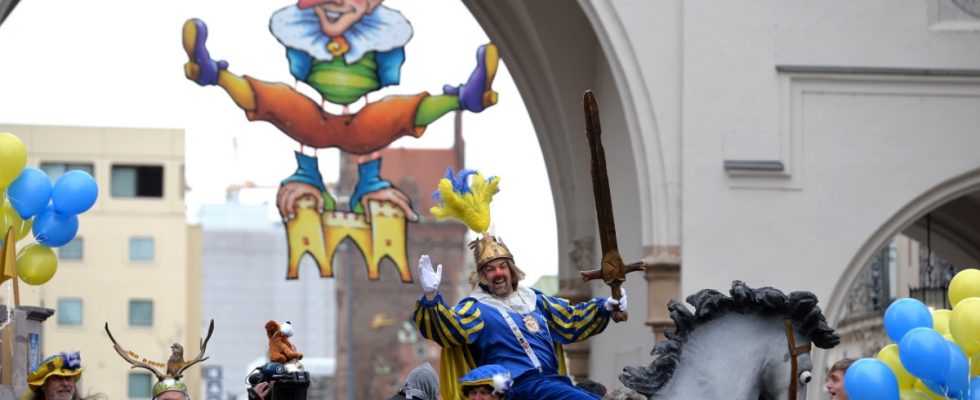Anyone who has ever tasted the Rhenish carnival and the Alemannic Fasnacht will probably be overcome by boredom when they see the Bavarian, or at least the southern Bavarian, carnival. The people of Munich, for example, are said to stand on the side of the road during carnival with the corners of their mouth hanging.
This is even confirmed by the city chronicle, which noted in 1910: “It is known from numerous descriptions that the people of Munich – unlike what is usual in the Rhineland – followed the carnival procession without any emotion. The organizers therefore felt compelled to make the following request: To the honorable Spectators! It is permissible to laugh. The procession may be greeted with cheers. There is no need to look bitter.” Anyone who reads this understands all too well the great philosopher Karl Valentin, who once said: “Carnival isn’t there for fun, my dear, that’s where the fun ends.”
There is very likely a big misunderstanding when it comes to carnival. The former district home administrator Paul-Ernst Rattelmüller (1924-2004) already explained that old carnival customs are not at all fun at their core, but rather a very serious matter. The week-long carnival celebration that we are experiencing today is more of a post-war phenomenon, confirms customs expert Michael Ritter from the State Association for Local Heritage. Parades, councils of eleven, guard girls – a lot of things were copied from the Rhenish carnival. While the local carnival with its redoubts and court balls used to have the character of a closed event, the Alemannic and Rhineland fools have always strived to be public.
Ultimately, the development of carnival was like that of language and customs: everything mixes, the elements are exchanged. For example in Benediktbeuern, where on Shrove Tuesday visitors experience not only the Maschkera procession but also a Haberfeld activity, a custom that actually has nothing to do with fun carnival. In the past, this was understood to be a court of reprimand, during which the Haberers reproached the accused for their (mostly moral) transgressions in verse form.
Against this background, it is difficult to come across original carnival traditions in the Munich area. The ski carnival on the Firstalm at Spitzingsee is at least one of the most original carnival events, but it was only invented in 1930. The seemingly archaic dance of the market women at Munich’s Viktualienmarkt probably doesn’t go back much further. At least there is a newspaper report in the city archives about the market woman dance from 1933, so it is not a post-war phenomenon like most Bavarian carnival parades.
The Hemadlenzen parade in Dorfen is one of the oldest carnival traditions still alive in the region. Nobody knows where the custom comes from, but the people of Dorfen already practiced it in the 19th century, that’s for sure. It is also true that this custom suits the sometimes rebellious villagers. In 1910, a beer war raged here that reached America. The fact that Dorfen, as some claim, is not a place but a state is underpinned by Hemadlenzen customs. It is as unique in Old Bavaria as the Chinese carnival in Dietfurt in the Altmühltal, where the fools wear Chinese clothes.
In Dorfen they put on white underpants and nightgowns. With great fanfare, the Hemadlenzen cart a straw doll through the city, only to hang it on a gallows with great jeering and burn it while singing brass music hymns. Tradition researchers suspect that this act symbolically drives out winter. Such hustle and bustle is common in many villages during the Alemannic and Swabian carnival – except that the Hemadlenzen there are called Shirtgluncker. This custom may have spread to Dorfen through an emigrant.
Elsewhere, too, rituals that are intended to drive away winter occur on the last days of Carnival. There is no conclusive explanation as to what connection there is between carnival and winter, as customs expert Ritter notes. Around the Karwendel Mountains on carnival days, for example, the bell stirrers make a huge racket with their cowbells. But as is the case with old customs in a global environment: their cultural-historical foundation is forgotten, the customs are occupied by meaningless drinking and shouting. Traditional festivals such as the Hemadlenzen parade were turned into events by the party-loving party people, the winter expulsion was accompanied by dozens of “alcoholic corpses” who actually don’t care about the old carnival customs. The city of Dorfen has pulled the ripcord (“we want Hemadlenzen and no Sauflenzen”); hard alcoholic drinks have no longer been allowed to be served for several years.
At the carnival parades in the Munich area (e.g. in Fürstenfeldbruck, Ismaning, Mauern, Gammelsdorf, Indersdorf, Petershausen, Ebersberg, Pliening or Weichs) there is a growing danger that incorrigible fools will overindulge in alcohol. But the Damische Ritter, who have been organizing a carnival parade in the city of Munich every year since 2006, have other worries. First of all, they would be happy if the people of Munich didn’t go down to the cellar to laugh.
This text appeared in the Süddeutsche Zeitung on February 25, 2011 and has been slightly revised.

